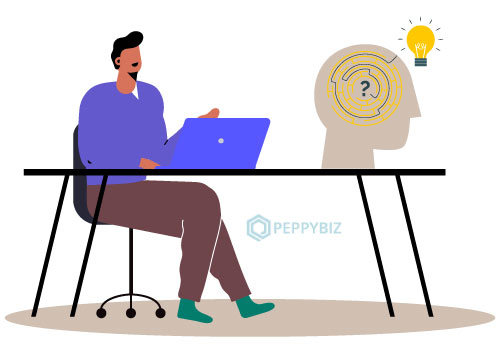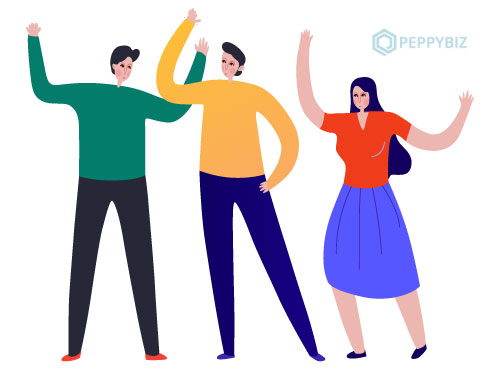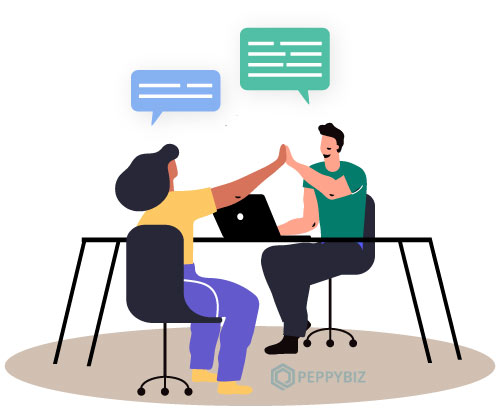What is Team Collaboration | Definition, Benefits and Strategies
Why do schools and colleges insist on having group activities? Because they are trying to develop a core value known as team collaboration. In a modern workplace, there are many people with different backgrounds and talents. But, what brings them together is the collective aim. Achieving the goal becomes a lot easier when everyone is on board with the idea. If not, the workplace is a disaster waiting to happen.
This blog will explain how collaboration impacts an organisation and what you can do to improve it. But first, let us cover some basics.
What is Team Collaboration?

A simple definition of collaboration would be ‘working together to make something useful’. When it concerns an organisation, it usually refers to the business goals and project outcomes.
Collaboration has teamwork, creative thinking and equal participation as the key factors that shape a positive corporate culture, ensuring employees work harmoniously toward shared goals. The rise in technology has proved as a beneficial tool in improving collaborative activities. The following are some other elements that make up an effective collaboration:
- Communication.
- Transparency.
- Accountability.
- Engagement.
- Compromise.
- Diversity.
With remote work on the rise, it’s crucial to invest in tools that smooth communication barriers. Effective collaboration hinges on leadership, where a key role is organizing and delegating tasks. You can find useful examples of delegation in the workplace to better understand this process. Additionally, managing offshore remote teams requires particular attention to payroll processing. Different countries have varied regulations and tax implications, which necessitates a robust system that can handle these complexities efficiently. This not only ensures compliance but also enhances the overall operational flow, making it easier for teams to focus on their core responsibilities.
Benefits of Team Collaboration
Now that we understand what collaboration is, let us take a look at how it benefits an organisation.
1. Promotes problem-solving:

A project that involves collaborative actions often tends to be a complex one. A complex project has more challenging situations to overcome than a normal project. But, by promoting collaboration, your team will learn problem-solving skills.
When you have a structure that promotes collaboration, your employees are more likely to solve problems on their own. It benefits your organisation with timely actions that result in faster project completion.
Example: Your regular raw material’s supplier suddenly drops out of business. In such a situation, the collaboration between the sales team, warehouse manager and procurement team will come in handy. They will be able to communicate the requirements and find a suitable supplier in no time.
2. Improves sharing of knowledge:
When teams work in silos, they do not have the opportunity to share their insights. People from varying backgrounds working together results in an effective team with mixed knowledge.
Example: Brainstorming sessions usually serve as an eye-opener for everyone in the team. Everyone gets to share the perspective they have towards a specific problem, improving the work quality.
3. Boosts productivity rate:

Organisations with effective collaborations usually see higher employee productivity rates because individual employees do not want to let the group down by their inactivity. Tools like kudos software can support this by making it easier to recognize and appreciate team efforts, which further motivates employees to stay engaged and contribute actively to group goals.
Example: Imagine that you have a project that involves the contribution of various talents at the same time. Effective collaboration will set communication channels between them, thus improving productivity.
4. Enhances adaptability:
Supporting change is vital to the company’s growth. Team collaboration places people with different perspectives in the same room. Helping the mass sway towards better decisions.
Example: A manager decides to implement new software that helps the team in project management. Since every employee has diverse opinions, some agree, and some don’t. This is where collaboration helps. The employees who understand the benefits of the software can help others embrace the change.
5. Organises remote teams:

Remote working conditions tend to isolate the employees from their co-workers. Improper communication between the team members results in a lack of efficiency. But collaboration highlights the necessity for modern tools that organise and streamlines project activities.
Example: To avoid isolation in a group project, your employees need to understand the basic details. Having a project management tool by your side helps inform the team members of their day-to-day activities. Thus turning these adverse situations in our favour.
6. Develops employee engagement:

One of the best ways to improve productivity is to keep your employees engaged. A collaborative workplace values everyone’s contribution, no matter the size. This results in higher engagement rates and wellness.
Example: Companies that have effective collaboration strategies see lower employee burnout and turnover rates. Employees feel stressed because they question their place in the organisation. A collaborative team reduces such stress by signifying the contribution of each member.
7. Eliminates vertical hierarchy:
Employees of lower roles might feel that their opinions do not matter in the organisation even though they might have excellent ideas. Collaboration removes such communication barriers by giving equal voice to every team member involved.
Example: A collaborative meeting calls all the people involved in the project. Any employee is free to share ideas and opinions. Thus promoting a work environment where vertical hierarchy is non-existent.
8. Increases the business revenue:

Collaboration usually leads to better time management and effective project management. It helps managers implement the best strategy for every project. Thus, it improves deliverability, which further contributes to the revenue of the company.
Example: Team collaboration results in employees becoming more oriented towards creating a positive work environment. Everything gets done within the deadline. Thus, it helps the company generate more profit and widens its credibility.
Strategies to Promote Team Collaboration
Now that we have proved that collaboration is useful let us address some common strategies to improve teamwork.
1. Set an example:
The only way to lead a collaborative team is by example. You have to do what you expect from the employees and serve as a role model. A leader’s behaviour should reflect the values of collaboration and teamwork. Since most employees tend to follow their managers/leaders, they adapt to these qualities as well.
Encourage team leaders to conduct open meetings where any team can join. You can also organise the meeting in a communal area to ensure an audience. If you are a leader, you must be ready to accept critics and be open to ideas from everyone. It lays the foundation for a constructive environment filled with productivity.
2. Facilitate communication:

This goes without saying. Communication is the key element for achieving effective collaboration. For effective employee engagement, you can deploy performance management and employee survey programs that allow 360 feedback and encourage your employees to communicate their ideas and opinions. They should not feel pressured by the seniority level when placing an opinion in the room.
That said, you also need a centralised communication channel for easy collaboration. No matter the location of the employees, you can attain higher productivity levels. Make it easy for them to speak by employing standard ways of communication.
3. Provide various collaboration modes:
Everyone on the team has different comfort zones and interests. Hence, their collaboration modes also vary. Some employees may be full of energy in face-to-face meetings, while others are silent spectators. The silent spectators might contribute after the meeting with innovative ideas through emails.
So you must validate your employees’ preferences. Be sure to select a tool that can switch from chats to video conferences. It will help you in these remote working conditions.
4. Employ the right tools:
Tools like project management software improve transparency and overall team productivity. There are other tools like marketing automation software. It helps promote the collaboration between the sales and the marketing team. Modern workplaces often face challenges requiring highly specialized tools tailored to team needs. One vital piece is using creative project management software, which streamlines the variety of tasks involved in creative processes such as face-to-face meetings, remote collaborations, and diverse project pursuits geared towards innovation and effectiveness.
Let’s not forget about HR software focusing on employee engagement with features like 360-degree feedback, performance reviews, engagement surveys, and much more. It helps foster meaningful conversations between employees and managers as well as measure overall workforce happiness.
Since most software uses automation of some kind, it can carry out routine tasks without human intervention. A standard communication tool will also help you track the progress of every task.
5. Set clear goals, roles and duties:
Team collaboration is all about using talents from various fields. Everyone will be doing different work but towards the same goal. Hence, you must assign specific roles for every team member. This way, you can improve accountability and thus productivity.
You also need to set up occasional meetings to ensure that the roles you assigned suit the employee. Also, make the employees understand how each task lines up with the ultimate goal.
6. Identify team members’ strength:
As a manager, it is your responsibility to put your employees to good use. To do that, you need to understand the strengths and weaknesses of your team members. You can start by sharing yours. It builds up confidence and trust. Highlighting weaknesses also let you plan training sessions to improve their value to the organisation.
7. Reward collaboration:

One of the best ways to encourage collaboration is to reward those who take part in it. It will encourage more employees to prioritise teamwork. You should start by explaining the benefits of collaboration to your team. Furthermore, you could use meetings as a platform to encourage collaborative initiatives.
8. Compromise:
When you put two or more individuals from different backgrounds in the same room, you are sure to get conflicts. Similarly, it is impossible to avoid disagreements in the workplace. When you are at fault, you must take responsibility. It instils trust and also creates an amicable workspace.
Team members also should compromise when someone comes up with a better idea. They must be able to think for the organisations and not as individuals. Leading by example is the best way to create such a positive environment.
Conclusion
An effective team collaboration takes a lot of time to come into effect. Even if your plans are effective, it all depends on the employees’ mindsets to do the right thing. Also, be sure that you provide modern tools to ease their way into collaboration and productivity.



